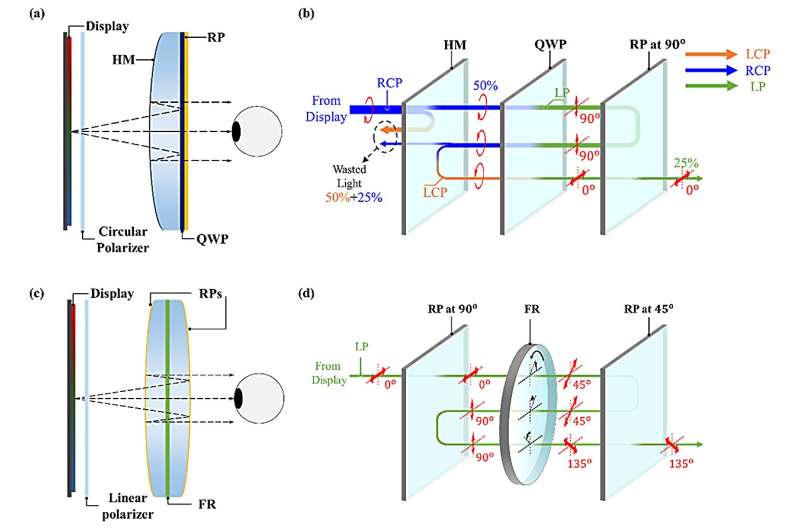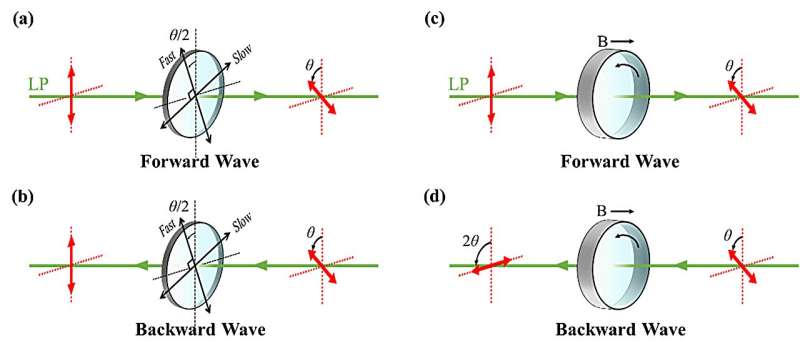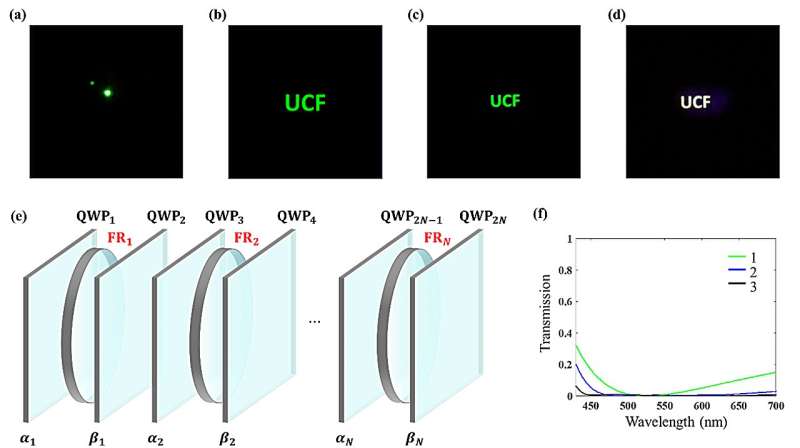This article has been reviewed according to Science X's editorial process and policies. Editors have highlighted the following attributes while ensuring the content's credibility:
fact-checked
proofread
Revolutionizing next-generation VR and MR displays with a novel pancake optics system

Augmented reality (AR), virtual reality (VR) and mixed reality (MR) have expanded perceptual horizons and ushered in deeper human-digital interactions that transcend the confines of traditional flat panel displays.
This evolution has unlocked a realm of exciting new possibilities, encompassing the metaverse, digital twins and spatial computing, all of which have found widespread applications in diverse fields such as smart education and training, health care, navigation, gaming, entertainment, and smart manufacturing.
For AR, VR and MR displays to become truly wearable for an extended period, there is a pressing need for compact and stylish form factor, low weight and low power consumption. Compared to Fresnel lenses and refractive lenses, polarization-based folded optics, often referred to as pancake optics, have emerged as a pivotal breakthrough for compact and lightweight VR headsets in the past few years, including Apple Vision Pro and Meta Quest 3.
These pancake optics greatly reduce the volume of a VR display, which in turn improves the center of gravity for the headset. However, the employed half-mirror causes considerable optical loss, which limits the maximum efficiency to 25%. Therefore, researchers are working toward a novel optical structure with the same folding capability as the pancake lens, but without the optical loss.
The authors of a new article published in Opto-Electronic Advances have extensively explored light engines, imaging optics, and power consumption of AR, VR and MR displays. A game-changing pancake optics system for reducing the volume of VR and MR displays, while keeping a high efficiency is proposed by this article.
The motivation behind this research is the increasing demand for wearable VR/MR headsets that are not only visually impressive but also comfortable for extended use. Present VR headsets with conventional pancake optics face challenges such as low optical efficiency, which in turn leads to increased thermal effect of the headset and short battery life due to the tremendous optical loss induced by the half mirror.
As depicted in Fig. 1 (a–b), only about 25% of the light (assuming no other loss) from the display panel reaches the observer's eye. However, if the microdisplay emits unpolarized light, then the maximum optical efficiency is further reduced to 12.5%. The unused light will be either absorbed by the headset, which would increase the thermal effect, or become stray light, which would degrade the image quality.
The novel pancake optics system addresses this challenge by introducing a theoretically lossless design, incorporating a nonreciprocal polarization rotator, also known as Faraday rotator, between reflective polarizers as shown in Fig. 1 (c–d). In such a design, the nonreciprocal polarization rotator plays a critical role in folding the optical paths.

Compared to reciprocal polarization rotator (e.g., half-wave plates), the nonreciprocal polarization rotator rotates the linearly polarized light irrespective of the optical wave's propagation direction as Fig. 2 depicts. Consequently, a round trip of forward and backward propagations through the nonreciprocal polarization rotator results in a net rotation of 2θ.

Preliminary experiments were conducted with a laser source and a micro-OLED panel to verify its optical efficiency and folding capability as depicted in Fig. 3 (a) and (b–c) respectively. The measured optical efficiency is around 71.5% due to the lack of anti-reflection (AR) coating and non-ideal performance of the employed reflective polarizers.
After using high-performance reflective polarizers and AR coating, the optical efficiency is improved to 93.2%, which is approaching the theoretical prediction. Additionally, four types of possible ghost images are analyzed in this novel pancake optical system. Through identifying the root cause of these ghost images, new methods are proposed to enhance the image contrast ratio. Additionally, a multi-layer structure is proposed to broaden the bandwidth of the Faraday rotator to enable full color displays.
As indicated in Fig. 3 (d–f), a three sequences of nonreciprocal polarization rotators and quarter-wave plates are adequate to achieve a broadband spectral response. Finally, to achieve a large field of view and truly compact formfactor, some possible candidates of thin-film magneto-optics material are analyzed and discussed in the article.
Overall, these demonstrations showcase the potential that such a novel pancake optics system could revolutionize next-generation VR and MR displays with lightweight, compact formfactor, and low power consumption. The pressing need for a thin-film Faraday rotator that is both magnet-free and highly transparent, while possessing a large Verdet constant in the visible region, is expected to inspire the next-round magneto-optic material development in the future.
More information: Yuqiang Ding et al, Breaking the optical efficiency limit of virtual reality with a nonreciprocal polarization rotator, Opto-Electronic Advances (2024). DOI: 10.29026/oea.2024.230178
Provided by Compuscript Ltd





















